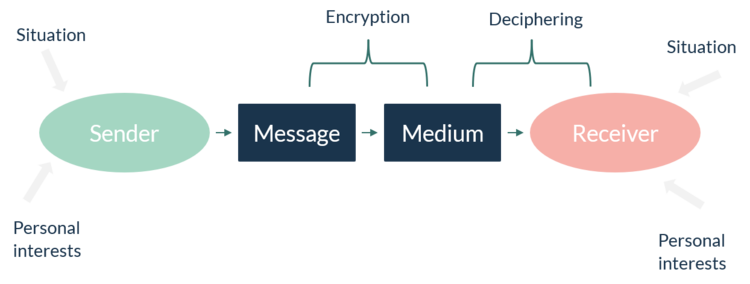How to Receive Feedback
Knowing how to give feedback is a great skill. If there is something critical that you want to address, you know how to do it in a non-violent, effective way. What happens though, if you receive feedback and the other person does not know how to give feedback in a non-violent way. This is the moment when receiving feedback becomes a key skill.
When people give feedback, they usually talk about themselves while using words about you. One example: When I say “You are driving too fast.” of course it contains a message about you. On the other hand, what I probably tried to express was that I am scared or that I want to stop somewhere and that’s why I want to check out the area which is easier in a slower car.
This whole concept of saying something while meaning something else is best described by the four sides of a message by Schulz von Thun in combination with the Shannon-Weaver-Model.
The sender has four different options for what s*he wants to say. For everything s*he says, s*he can communicate on four following levels. If you take the sentence "I am hungry." as an example, it can have several different meanings:
Facts: It’s 12:30 pm, s*he last ate at 7 am.
Appeal: Go to lunch with me. / Bring me something to eat.
Self-revelation: I don’t want to go to lunch myself. / I am moody. / I have to finish something before 1pm and have problems to focus. I am afraid I won’t be able to finish on time.
Relationship: I like you and feel comfortable to share my concerns with you. / I like to spend time with you during lunch. etc.
The fact level describes a situation. It does not contain judgements or interpretations. The appeal describes what the sender wants the receiver to do. There is a certain task or action item behind / within the sentence that addresses what the receiver should do, refrain, think or feel.
The self-revelation contains the message about the sender itself. How s*he feels and what kind of needs are met or unsatisfied. The relationship-level describes the character of the relationship. It contains an assumption or a perception of how the sender sees the relationship towards the receiver.
The sender encrypts her / his message by unconsciously choosing one side of the message that is the most important one. The receiver on the other hand deciphers the message by choosing maybe a different side of the message. This is how misunderstandings evolve and the conversation takes its own dynamics.
One more example
In the example above, it could be a mom / dad, talking to their kid. Maybe the kid wanted to clean up the room anyways but now that the parent said it, s*he won’t do it anymore - just because s*he thinks the parent is not the boss and should not tell her / him what to do. A disagreement on the relationship level has a lot of conflict potential.
This is also a nice example for how conflicts within teams evolve. You might agree on the fact level itself - the room is dirty and needs to be cleaned - but if the process behind this decision was not designed well - let’s say one person tells all the others to clean up - the team won’t do it.
How is this related to receiving feedback?
Many times, when we give feedback, we don’t know what our problem is exactly. When we receive feedback, our first assumption should be, that the feedback giver wants to say something about him / herself and not about us. So when we receive feedback it’s our job to find out what the feedback giver actually wants to say about him / herself.
Your tool for finding the core of the problem is called active listening. When you listen actively, you do the following:
Reflect content:
It’s important to you that…
You mean…
You did xy...
Summarize, Paraphrase
Ask questions to specify
Ask questions about feelings and needs / reflect them
Pay full attention
Listen and nod
One thing that is particularly important here is, that we don’t add content ourselves. Many times, when someone is telling us something, we immediately have this thought of how the same thing happened to us once or something else that makes us relate to the content. While listening actively, we don’t add that to the story because it will distract us from the other person. Our full focus is on understanding what the world of the other person looks like without thinking about how this fits into our world.
Many times, when we think we know what the other person is talking about, we actually don’t know it. Listening actively means, that you don’t only say “I know what you mean.” You say: “I know what you mean. It’s when you feel really frustrated because you are in a hurry and no one notices that or maybe they do notice and then they don’t bother to get out of your way.” After repeating what you understood, the person can agree or disagree and you will be able to reach a whole different level of understanding.
People love talking about themselves
People love to talk about themselves. They feel appreciated and well connected if you listen actively. They also start to understand themselves much better because you are pointing out things that they haven’t thought about before. Even if you repeat and summarize three times what the person just said, s*he won’t get bored of it. Try it.
If the person was really angry when starting to talk, s*he will calm down during the conversation. You are able to build up trust and connect on a different level. The feedback will turn out to be more effective and it's probably not even about you anymore. Maybe the person just wanted to express how s*he felt and this might not be related to you at all.
Exercise
To practice listening actively, practice with two colleagues (or friends). With three people, one will give feedback, one will listen and one will observe.
The feedback giver will think of three different things that made him / her really mad. S*he will just start to give the feedback right away without thinking of a good way for how to give feedback. S*he can just complain and be angry.
The receiver will try to find out what exactly the problem is by listening actively. I recommend that you make a list with the things to do while listening actively (summarize, paraphrase etc.) so you will remember what to do exactly.
The observer will observe the teqchines that are used. On top, you will also try to find out what the problem is. If you have the feeling the receiver is not on the right track to fully understand the problem, you can ask for a time out and quickly discuss your idea with the receiver. S*he can then try to use the input / your ideas and continue. In the end, you ask the receiver: “What was the sender’s problem?” If the sender then agrees, that this (the answer) was the problem, the listener accomplished the mission.
The three of you can now analyze what went well and what could have been different. Then you rotate and try again with each of you having a different role than before.














Spätestens seit dem 2. Lockdown sind wir daran gewöhnt, im Homeoffice Videokonferenzen, Co-Kreative Online-Meetings Projekt-Updates, Webinare, Sales Pitches, Vorstellungsgespräche, ganze Onboarding-Prozesse und Teambuilding parallel durch 5 verschiedenen Tools durchzuführen. Brauchen wir dann überhaupt noch das Office?